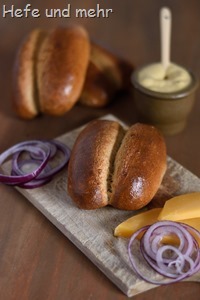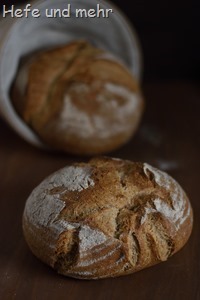 Sometimes it can happen even in a bread loving household: no bread! This happened to me some weeks ago when we had to defrost our freezer and so started to eat our way through all frozen goods. And then – in the middle of my working week – all bread was eaten and only to lonely rolls where left in the freezer. Enough to ensure our breakfast the next morning – but for the rest of the week we needed bread. And so I checked the flour stocks, took out some sweet starter and sourdough from the fridge and kneaded a dough before I went to sleep. The dough rested in the fridge meanwhile.
Sometimes it can happen even in a bread loving household: no bread! This happened to me some weeks ago when we had to defrost our freezer and so started to eat our way through all frozen goods. And then – in the middle of my working week – all bread was eaten and only to lonely rolls where left in the freezer. Enough to ensure our breakfast the next morning – but for the rest of the week we needed bread. And so I checked the flour stocks, took out some sweet starter and sourdough from the fridge and kneaded a dough before I went to sleep. The dough rested in the fridge meanwhile.
Tag Archives: Sourdough
Porridge Bread with roasted Buckwheat
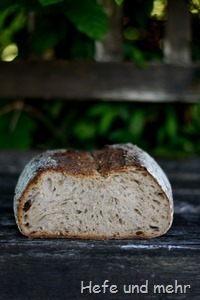 Some breads sneak their way into my my mind and stay there for awhile while my subconscious mind works on the recipe. This time it was a short sentence about a bread MC from Blog Farine tasted in Sandeep Gywalis Bakery: Porridge and roasted buckwheat, filled with many complex flavour notes. There was not much more information but this was enough for my brain to come up with a recipe.
Some breads sneak their way into my my mind and stay there for awhile while my subconscious mind works on the recipe. This time it was a short sentence about a bread MC from Blog Farine tasted in Sandeep Gywalis Bakery: Porridge and roasted buckwheat, filled with many complex flavour notes. There was not much more information but this was enough for my brain to come up with a recipe.
The monthly bread baking day in the local museum Bergneustadt was the perfect opportunity to bake the bread. Because what can make a delicious bread even more delicous? Right – baking it in an old wood fired community oven! And so I roasted the buckwheat the night before and then milled the roasted kernels to a fine, dark brown flour. The smell of the flour was astonishingly delicious: Malty and buckwheaty notes creates a rich and deep flavour. And it was suprising how much water the flour needed when I mixed the sourdough with this flour. The sourdough developed rather strong sour note.
Potato Rye Bread
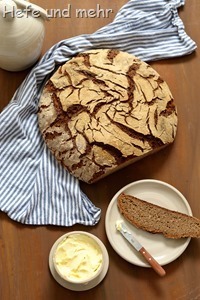 Already for some time I had the idea of a mild aromatic pure rye bread in my mind. But I need – as everyone knows – someone to share breads with high percentage. A big family get together for which I volunteered to bake all bread needed was the chance to bring my idea of this bread to life.
Already for some time I had the idea of a mild aromatic pure rye bread in my mind. But I need – as everyone knows – someone to share breads with high percentage. A big family get together for which I volunteered to bake all bread needed was the chance to bring my idea of this bread to life.
My wild sourdough was build in to stages to ensure both mild flavour and good strength to rise the loaf. But at the moment my sourdough is a bit to wild and the second stage doubled its volume after just one hour. That was to short to develop enough lactic acid and other flavour components. And so I placed the bowl at a cooler spot and let it ripe for another two hours until the flavour of the sourdough was right. But the amazing power of this sourdough was unbroken. After not even one hour(instead of the normal two) the loaf peaked over the rim of the proofing basket.
Caraway Seed Bread
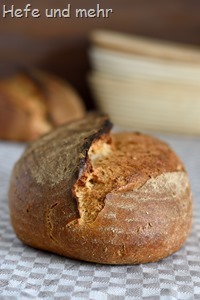 Sometimes the spontaneously created breads are the best. Breads that base on the actual stock in the ktichen cupboards can turn out to be new favourites, just like this potato rolls. And this caraway seed bread follows this route.
Sometimes the spontaneously created breads are the best. Breads that base on the actual stock in the ktichen cupboards can turn out to be new favourites, just like this potato rolls. And this caraway seed bread follows this route.
After refreshing my differnt starters I had some leftovers that needed to be used. And as I planed to visit my uncles birthday party later this day I decided to bake a bread that would make him happy: Caraway Seed bread.
Das Urige
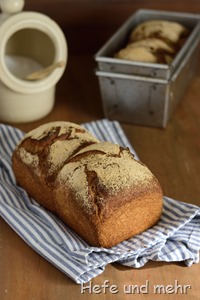 Inspiration is a strange thing: there are phases with only few ideas and then there are phase when my mind is so full that I nearly don’t know which bread I should bake first. At the moment I have so many recipe drafts waiting to a test bake. And then comes a new recipe idea from a reader and sometimes I like the idea so much that it overtakes them all.
Inspiration is a strange thing: there are phases with only few ideas and then there are phase when my mind is so full that I nearly don’t know which bread I should bake first. At the moment I have so many recipe drafts waiting to a test bake. And then comes a new recipe idea from a reader and sometimes I like the idea so much that it overtakes them all.
The description of the Urigs-Brot was such a case. A moist bread with fine crumb and mild sourdough flavour, baked in a pan with the seam side up. I was hooked and started to draft the recipe immediately. As I prefer to bake with local grains and flours instead of importing it from all corners of the world, I had to change from “Ruchmehl” to Flour type 1150. With some physillium husks for more moisture and two different sourdoughs and a cold rise in the fridge for a deep, complex flavour. Continue reading
Gersterbrot
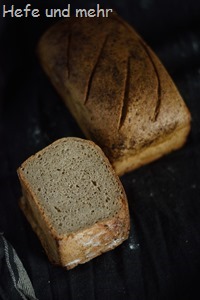 When I asked for suggestions of regional traditional Bread one bread on top of the list of favourites was Gersterbrot. This bread stems from the region around Hanover and Bremen and it is really special as it is flambéd after forming the loaves. This seals the crust and adds dark speckles all over the bread. Both lead to a bread with a hearty flavour and beautiful crisp crust. And it enhances shelf live as well as the thick crust prevents the moisture from evaporating.
When I asked for suggestions of regional traditional Bread one bread on top of the list of favourites was Gersterbrot. This bread stems from the region around Hanover and Bremen and it is really special as it is flambéd after forming the loaves. This seals the crust and adds dark speckles all over the bread. Both lead to a bread with a hearty flavour and beautiful crisp crust. And it enhances shelf live as well as the thick crust prevents the moisture from evaporating.
To flambé the loaf properly I bought a small blazing torch as it develops more heat then a flambé torch. And when I flambéd the bread I took care that the surface below was fire proof! And I had a wet towel near just in case… But everything worked perfectly fine, no kitchen on fire, just a beautiful bread with a fine crumb and the thin crust – just as it has to be!
Rhenish Blackbread
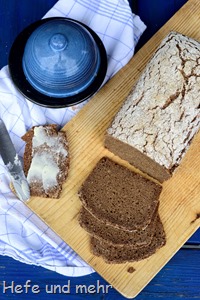 The grandmother of my dearest complained that today you can not get real blackbread anymore. The “modern” one is to moist in her opinion. When I asked how a “real” blackbread should be, she answered: “Just like it once had been”. My argument that I do not know how the bread looked like ninety years back in the past just gained me a critical gaze. But at the end I could get some informations about her childhoods blackbread from her: moist, but not so moist we today, dark and baked with rather fine cracked rye. And my ambitions was aroused to recreate this bread for her.
The grandmother of my dearest complained that today you can not get real blackbread anymore. The “modern” one is to moist in her opinion. When I asked how a “real” blackbread should be, she answered: “Just like it once had been”. My argument that I do not know how the bread looked like ninety years back in the past just gained me a critical gaze. But at the end I could get some informations about her childhoods blackbread from her: moist, but not so moist we today, dark and baked with rather fine cracked rye. And my ambitions was aroused to recreate this bread for her.
And so I bake a blackbread with the classical way: sourdough made with fine cracked rye, a soaker with roasted bread crumbs and coarse cracked rye and a good portion molasse. I added a bit of dark roasted rye malt to enhance the deep malt flavour. I baked it in the middle of the week when we spent some days with our Gran. And when we cut the bread the next day, everyone was happy, even Gran liked the bread!
Moist Spelt
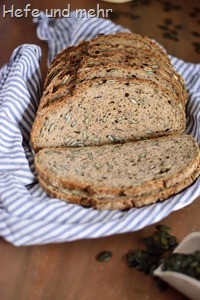 Last November a reader asked for a recipe of a moist spelt bread with high whole grain portion and different seeds. I had an idea for the bread very quickly: With a whole rye sourdough, many pumpkin seeds, some flax seeds and sesame and a good portion whole spelt flour – partly in a water roux for more moisture. But then the pysllium husk discovery happend and I changed my plan fastly. Instead of a water roux I decided to use the pysllium hulls to increase water binding. And I added some butter which makes the crumb nicely soft and helps to keep it fresh.
Last November a reader asked for a recipe of a moist spelt bread with high whole grain portion and different seeds. I had an idea for the bread very quickly: With a whole rye sourdough, many pumpkin seeds, some flax seeds and sesame and a good portion whole spelt flour – partly in a water roux for more moisture. But then the pysllium husk discovery happend and I changed my plan fastly. Instead of a water roux I decided to use the pysllium hulls to increase water binding. And I added some butter which makes the crumb nicely soft and helps to keep it fresh.
The result is a moist and aromatic bread. The crumb is full of pumpkin seeds and a thick crunchy crust. A bread with potential for a a favourite!
Luftikusse
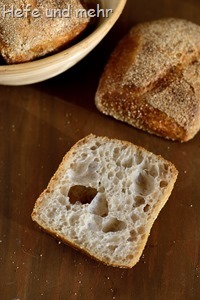 The first post in 2017 found its inspiration back in 2016. When I put together my “Best of 2016” I stumbled upon upon a readers question for rolls with open crumb. Back then I suggested this Baguette rolls and then the question slowly slipped from my mind. It has a simple reason: I normally prefer rolls with a finer crumb as we eat them mainly for breakfast and a wide open crumb means honey dropping all over the place. But during vacations we like to eat rolls for lunch or dinner, too. And with a slide of cheese a chiabatta-like roll is a delicious thing.
The first post in 2017 found its inspiration back in 2016. When I put together my “Best of 2016” I stumbled upon upon a readers question for rolls with open crumb. Back then I suggested this Baguette rolls and then the question slowly slipped from my mind. It has a simple reason: I normally prefer rolls with a finer crumb as we eat them mainly for breakfast and a wide open crumb means honey dropping all over the place. But during vacations we like to eat rolls for lunch or dinner, too. And with a slide of cheese a chiabatta-like roll is a delicious thing.
But the infection I catch before christmas was a mean one and so I spent most of my vacation on the sofa with hot tea and a good book – slowly recovering. I slept a lot, but baked nearly nothing and we went not for shopping food either but feed on our well stocked pantry and fridge. When we finally had to buy some groceries I discovered something new in our supermarket: organic pysillum hulls. I find their water binding capacity fascinating and so a package went home with me.
Röggelchen
In the cologne pubs (called “Brauhaus”) exists a dish with confuse tourists regulary. It is called “Halve Hahn” and the tourists translate this with “half rooster” and expect to get a half roasted chicken when they order it. What they get is one half of twin-roll together with old gouda cheeses, mustard and some onions. There are many theories to explain the name of the dish – one is that once upon time someone asked in the cologne dialect if he could get on half of the roll: “Ääver isch will doch bloß ne halve han” (But I want just one half).
The roll that comes with the dish is called “Röggelchen” (little rye) and is baked as twin roll. You can tell in which city the roll was baked by the way it was formed: The Röggelchen from Düsseldorf has a round shape while the Cologne one’s shape is long. Both in common is that they are made partly with rye. In this variant the rye is used to make a sourdough, which adds complex flavour notes to the rolls. Another typical characteristic is the dark, shining crust which is due to a glazing which is made with roasted starch and applied before and after baking.

